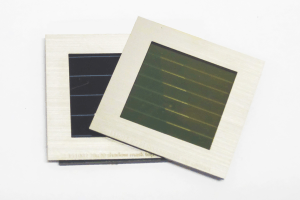Sep 28 2016
 Prototype tandem solar module made up of a semitransparent perovskite solar module (on top) and a CIGS solar module (below). (Picture: imec/ZSW/KIT)
Prototype tandem solar module made up of a semitransparent perovskite solar module (on top) and a CIGS solar module (below). (Picture: imec/ZSW/KIT)
An efficiency of 17.8% has been achieved in a prototype of a perovskite/CIGS tandem thin-film solar module. This is the first time the efficiency of a single peroviskite and CIGS solar module has been surpassed.
The cost of next-generation solar modules can be significantly reduced by thin-film technologies. While their production cost is low, it is specifically the integration of complementary absorber materials in a tandem solar module that results in increasing the power conversion efficiency.
The PSCO international conference in Genova was attended by researchers from ZSW, KIT, and the Belgian research institute imec. The researchers presented a perovskite/CIGS tandem thin-film solar module capable of achieving 17.8% in efficiency, exceeding the efficiency of individual perovskite and CIGS solar modules for the very first time.
Our prototype demonstrates that scalable perovskite/CIGS solar modules can drastically surpass the efficiency of a separate solar module made of these materials.
Dr. Ulrich W. Paetzold, KIT
Paetzold recently established group of young investigators at KIT’s Institute of Microstructure Technology and Institute of Light Technology examines and optimizes energy efficiency and light trapping in these tandem solar modules.
Professor Michael Powalla, leader of the Thin-film Photovoltaics Division at KIT and also a member of the board and head of the Photovoltaics Division at ZSW, highlights that: “The novel stacked module is an elegant way of making optimum use of a large part of the solar spectrum by combining the advantages of two highly innovative thin-film technologies.”
However, the semitransparent upper perovskite solar module has the potential to efficiently absorb the solar spectrum’s high-energy portion, and the lower CIGS layer transforms the infrared parts. In total 17.8% of energy conversion efficiency is obtained by the prototype. The existing world record for perovskite modules on this scale is at 15.3%, whereas the reference CIGS solar module comprises of an efficiency of 15.7%.
A completely scalable device concept corresponding to industrial requirements is implemented by the stacked module. The CIGS bottom module and the perovskite top module together feature an aperture area of 3.67 cm2 and a monolithic interconnection scheme, using 4 and 7 module cell stripes respectively.
The loss in the area amounts to less than 8% for both the technologies. The interconnection is capable of being laser-processed, permitting industrial scaling to stacked modules of numerous square meters. Earlier reports linked to this technology have been restricted to extremely small scale solar cells. The current achievement pushes the technology to a bigger area and scalable solar module architecture, which exhibits outstanding power conversion efficiencies.
This result was made possible by combining the complementary world-leading expertise of the three partners in a very fruitful collaboration.
Tom Aernouts, Team Leader Head of Thin-Film PV Research, imec
The Belgian research institute imec is a leading manufacture of semitransparent perovskite solar modules. ZSW is the founder in the development and scaling of CIGS-based solar cells and modules, and also holds a record of 22.6% for CIGS thin-film solar cells, which are the fundamental elements for solar modules that are interconnected.
The Helmholtz Young Investigators Group at KIT, led by Dr. Ulrich W. Paetzold, analyzes the optics existing in these components and produces new nanophotonic materials in order to enhance light harvesting.